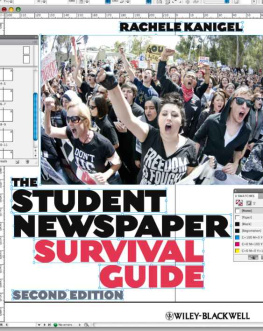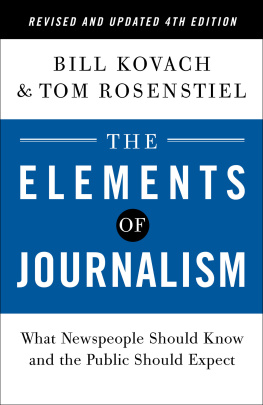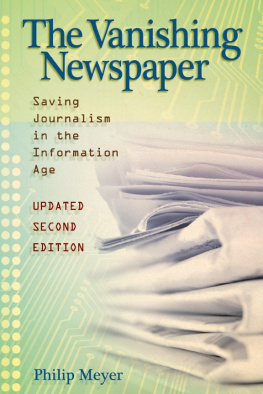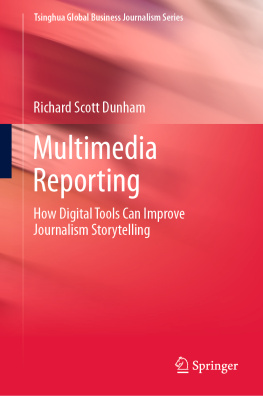CONTENTS

This second edition first published 2012
2012 Rachele Kanigel
Edition history: Blackwell Publishing Professional (1e, 2006)
Blackwell Publishing was acquired by John Wiley & Sons in February 2007. Blackwells publishing program has been merged with Wileys global Scientific, Technical, and Medical business to form Wiley-Blackwell.
Registered Office
John Wiley & Sons Ltd, The Atrium, Southern Gate, Chichester, West Sussex, PO19 8SQ,
United Kingdom
Editorial Offices
350 Main Street, Malden, MA 02148-5020, USA
9600 Garsington Road, Oxford, OX4 2DQ, UK
The Atrium, Southern Gate, Chichester, West Sussex, PO19 8SQ, UK
For details of our global editorial offices, for customer services, and for information about how to apply for permission to reuse the copyright material in this book please see our website at www.wiley.com/wiley-blackwell.
The right of Rachele Kanigel to be identified as the author of this work has been asserted in accordance with the UK Copyright, Designs and Patents Act 1988.
All rights reserved. No part of this publication may be reproduced, stored in a retrieval system, or transmitted, in any form or by any means, electronic, mechanical, photocopying, recording or otherwise, except as permitted by the UK Copyright, Designs and Patents Act 1988, without the prior permission of the publisher.
Wiley also publishes its books in a variety of electronic formats. Some content that appears in print may not be available in electronic books.
Designations used by companies to distinguish their products are often claimed as trademarks. All brand names and product names used in this book are trade names, service marks, trademarks or registered trademarks of their respective owners. The publisher is not associated with any product or vendor mentioned in this book. This publication is designed to provide accurate and authoritative information in regard to the subject matter covered. It is sold on the understanding that the publisher is not engaged in rendering professional services. If professional advice or other expert assistance is required, the services of a competent professional should be sought.
Library of Congress Cataloging-in-Publication Data
Kanigel, Rachele.
The student newspaper survival guide / Rachele Kanigel. 2nd ed.
p. cm.
Includes bibliographical references and index.
ISBN 978-1-4443-3238-4 (pbk.)
1. College student newspapers and periodicals. I. Title.
LB3621.65.K36 2011
378.19897dc22
2011017891
A catalogue record for this book is available from the British Library.
This book is published in the following electronic formats: ePDFs [9781444344486]; ePub [9781444344493]; Kindle [9781444344509]
To the students at San Francisco State University and California State University, Monterey Bay, who inspired me .
To the members of College Media Advisers, who guided and counseled me .
And to my family Laird, Dashiell and Trevor who put up with me while I wrote this book .
PREFACE
I n 2005, when I wrote The Student Newspaper Survival Guide , less than 40 percent of North Americans had broadband Internet service at home, Facebook was still called thefacebook.com, YouTube had just launched and Twitter was something little birds did. Most student newspapers at the time published stories in print before posting them online, and few had taken more than a tentative step into the world of multimedia storytelling.
Its hard to believe how much things have changed in just a few years. Today, people are accustomed to watching video not just on their computers (more than 68 percent have high-speed Internet at home), but also on iPods, cell phones and tablet PCs. Many college students spend more time on social media than they do sleeping. Mobile media and multimedia have radically transformed student newspapers into 24-hour news organizations that publish on multiple platforms.
This new edition of The Student Newspaper Survival Guide is designed to help you make sense of these changes and figure out how to make your news organization more effective, more efficient and more creative.
In it youll find:
A new chapter on multimedia that explains the basic concepts of digital storytelling and offers tips on recording audio, shooting and editing video, producing slideshows and creating interactive graphics, maps and databases
A new chapter on social media that will help you use Facebook, Twitter, CoveritLive, Storify and other tools to find news, report it and distribute it widely
An expanded chapter on covering a campus that offers tips on localizing international and national stories, reporting on higher education and writing about science and medicine
A new section on computer-assisted reporting
A revised chapter on websites that explores in greater detail how to use online and mobile technology to report breaking news
An expanded chapter on newswriting that includes more examples from award-winning student stories
Tips from a veteran sportswriter on how to produce a great college sports section
10 ethical dilemmas you can discuss with co-workers at a training session or editors meeting
An expanded chapter on advertising that now includes sections on marketing and distribution
More examples of page design from some of the top student designers in the country
An expanded chapter on editing that includes sections on planning special projects and working with a student media board
A revised chapter on reporting that includes advice on how to cover breaking news and traumatic events.
To research The Student Newspaper Survival Guide I studied campus newspapers from around North America struggling publications with small staffs as well as impressive, professional-quality newspapers that routinely sweep awards contests. I interviewed professional journalists, journalism educators, student newspaper advisers and business managers.
I also talked to students hundreds of reporters, editors, photographers, columnists, ad sales people and webmasters asking each of them what challenges they faced and what advice they had for the next generation of student newspaper staffers. This volume is a compendium of their suggestions.
If youve picked up this book, youre probably part of a student newspaper staff, or soon will be. You may be an editor or reporter, a photographer or designer, an ad salesperson or a business manager. Or perhaps youre a student newspaper adviser looking for new ways to train, motivate and inspire your staff.
Whatever your role, welcome. Whether youre doing this for a class, checking out a potential profession, or just want to have fun, working for a student newspaper is one of the most eye-opening and empowering experiences you can have in college.
It also can be one of the most challenging. Over the months or years you work on a newspaper, you will encounter many obstacles. People you need to interview wont want to talk with you, subjects will decline to be photographed, businesses will refuse to buy ads. People you depend on will let you down. Heated debates will break out in the newsroom over photos and stories and headlines and ads. Youll face ethical and legal issues you dont know how to deal with.
This book is designed to help you cope with these challenges and to give you the resources you need to make reasoned decisions.
The first chapters of the book focus on editorial issues everything from recruiting and training a staff, to photographing sports and campus events, to steering clear of legal minefields. Heres where advisers, editors, reporters and photographers can look for guidance and ideas on the issues they deal with on a day-to-day basis.











